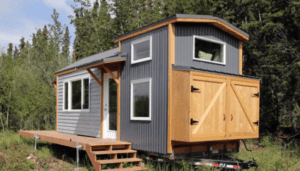There is a real hype about tiny houses right now. Many fans living in the smallest spaces want to live more ecologically and sustainably. But are tiny houses as sustainable as they are made out to be? Tiny houses are considered the ideal solution for balancing the need for a home on a tight budget. In the meantime, however, many people are also interested in a tiny house because they want to live more sustainably.
But is that the case? Tiny house and sustainability – do they go together? We name the ecological advantages and disadvantages of the tiny houses, and finally, dare to conclude.
Ecological Advantages of Tiny Houses
Some ecological advantages of Tiny Houses are obvious: CO2 emissions are lower; you avoid wasting space and live more sustainably and consciously overall.
Less CO2 emissions
The less living space someone lives in, the lower their CO2 emissions. The average living space per capita in the world is 46.5 square meters. Buildings cause almost a third of all CO2 emissions. Tiny houses are limited to the essentials and use the available space efficiently – they usually get by with a living area of less than 20 square meters.
The smaller the living space, the fewer resources are required for construction and operation. A second bathroom, a vast attic – conventional single-family homes often has unnecessary living space that needs to be maintained and heated. This not only costs money and time but also causes additional emissions.
According to a study by New York’s Saint John’s University, the CO2 emissions of a property can be reduced by 36 percent during its life cycle by halving the living space.
Tiny houses save space.
The tiny houses save space anyway – you can set them up where there is not enough space to construct conventional real estate. Even flat roofs can serve as a building site.
Tiny homes are built on wheels also contribute to sustainability – surfaces are not sealed for this. And if life circumstances require a change of location, you take your home with you.
Recycled and ecological materials
Many providers build tiny houses from recycled materials or use ecological building materials. They are often more expensive than conventional building materials, but the higher price is not as significant as traditional single-family houses because of their small size.
Tiny houses are often self-sufficient.
Another idea of the tiny house movement is that the houses should be as self-sufficient as possible. Some collect rainwater, and others have solar panels for hot water and a photovoltaic system for electricity generation on the roof.
And often, a composting toilet is built-in. Unlike regular toilets, this does not use any water. An utterly self-sufficient life in a tiny house is probably the maximum sustainability.
Less space equals less consumption.
Those who have little space consume less. Tiny house residents inevitably consume less and more consciously – and thus leave a smaller ecological footprint.
Ecological disadvantages of tiny houses
There is much to suggest that tiny homes are more sustainable than conventional real estate. However, it would help closely because tiny houses also have some ecological disadvantages.
No energy certificate
Neither the Energy Saving Ordinance nor the Renewable Energy Sources Heat Act applies to houses with less than 50 square meters of floor space. Therefore, manufacturers of tiny homes do not have to issue an energy certificate.
Anyone who wants to move into a tiny house for ecological reasons should therefore check for themselves how energy-efficient the place is.
Poor insulation, high heating costs
Small does not automatically mean economical. Many tiny houses have structurally – they should be as light as possible and thick walls would be at the expense of living space – thin outer walls and floors and ceilings that are not sufficiently insulated when conventional materials are used. It results in high heating costs.
A passive house, for example, can consume less energy than a tiny house despite having a larger living area. Only if the insulation, location, and building material are comparable will the energy requirement of the mini house be lower than that of a large house.
Not barrier-free
In addition, very few tiny houses are barrier-free – the sleeping area is often only accessible via stairs or ladders. Therefore, this form of living is less suitable for older people, who usually have to move back into a conventional apartment. And frequent moving also means less sustainability.
Tiny houses are often second homes.
And if the tiny house is not used as a primary residence but as a holiday home or weekend home, as many fans presumably do, the ecological balance is negative. After all, additional resources are consumed, and sustainability is gone.
Conclusion
Tiny houses have many ecological advantages and are often more sustainable than conventional real estate – but this is often also due to the lifestyle and attitude of the target group. Anyone who decides to lead a reduced life, that is, lives more sustainably and consciously.
However, you should look closely at the mini houses: A tiny house made of cheap materials and blows the wind has a lousy energy balance and is also not durable. When asked about the sustainability of tiny homes, you have to say that it depends on the design. Anyone who invests in durability and does not place the tiny home as a weekend cottage somewhere in otherwise untouched nature can have a clear ecological conscience.
Also read Are Tiny Homes a Good Investment?










